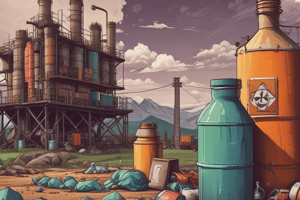Podcast
Questions and Answers
Which characteristic does NOT define a hazardous material?
Which characteristic does NOT define a hazardous material?
- Corrosive
- Toxic
- Flammable
- Innocuous (correct)
What is a characteristic of hazardous waste?
What is a characteristic of hazardous waste?
- It may increase mortality or illness when mismanaged. (correct)
- It poses no risk when disposed of in landfills.
- It must always be recycled.
- It can be safely burned without regulations.
How is plasma best described?
How is plasma best described?
- A solid state of matter.
- A gas with ionized particles. (correct)
- A nonconductive material.
- A liquid with a high density.
In what way is a solid waste defined?
In what way is a solid waste defined?
What best describes specific gravity?
What best describes specific gravity?
Which of the following is NOT considered a hazardous material?
Which of the following is NOT considered a hazardous material?
What is a key effect of improper management of hazardous waste?
What is a key effect of improper management of hazardous waste?
What is the main focus of the solid waste program under RCRA Subtitle D?
What is the main focus of the solid waste program under RCRA Subtitle D?
What does the hazardous waste program under RCRA Subtitle C primarily establish?
What does the hazardous waste program under RCRA Subtitle C primarily establish?
What act encourages citizen participation in decisions regarding hazardous waste site cleanups?
What act encourages citizen participation in decisions regarding hazardous waste site cleanups?
Which of the following substances is excluded from RCRA regulations?
Which of the following substances is excluded from RCRA regulations?
Under the Federal Insecticide, Fungicide, and Rodenticide Act, how are pesticides classified?
Under the Federal Insecticide, Fungicide, and Rodenticide Act, how are pesticides classified?
What is a primary goal of the programs mentioned in the content?
What is a primary goal of the programs mentioned in the content?
What is a key requirement of the Asbestos Model Accreditation Plan?
What is a key requirement of the Asbestos Model Accreditation Plan?
When does the EPA require asbestos removal according to the Asbestos Hazard Emergency Response Act?
When does the EPA require asbestos removal according to the Asbestos Hazard Emergency Response Act?
What is one regulatory aspect of the UST program under RCRA Subtitle I?
What is one regulatory aspect of the UST program under RCRA Subtitle I?
What is considered a critical element of hazardous waste operations?
What is considered a critical element of hazardous waste operations?
Which characteristic is NOT a requirement for a pesticide to be sold or used?
Which characteristic is NOT a requirement for a pesticide to be sold or used?
What has increased attention towards hazardous waste sites primarily focused on?
What has increased attention towards hazardous waste sites primarily focused on?
What is an outcome of the concern over public protection from chemical emergencies?
What is an outcome of the concern over public protection from chemical emergencies?
Which statement is true regarding the classification of most pesticides?
Which statement is true regarding the classification of most pesticides?
What is one of the main uses of reliable measurements of airborne contaminants?
What is one of the main uses of reliable measurements of airborne contaminants?
Which of the following best describes the purpose of Personal Protective Equipment (PPE)?
Which of the following best describes the purpose of Personal Protective Equipment (PPE)?
What is the role of site control in hazardous waste management?
What is the role of site control in hazardous waste management?
What does the decontamination process involve?
What does the decontamination process involve?
What does NEPA stand for?
What does NEPA stand for?
Which activity is part of the NEPA process?
Which activity is part of the NEPA process?
Which of the following is NOT a primary concern of site control?
Which of the following is NOT a primary concern of site control?
Why are airborne contaminants monitored?
Why are airborne contaminants monitored?
What is the intended outcome of the NEPA evaluation process?
What is the intended outcome of the NEPA evaluation process?
What is the focus of the Council on Environmental Quality (CEQ)?
What is the focus of the Council on Environmental Quality (CEQ)?
What is the primary purpose of the Resource Conservation and Recovery Act (RCRA)?
What is the primary purpose of the Resource Conservation and Recovery Act (RCRA)?
What does the Environmental Assessment (EA) aim to determine?
What does the Environmental Assessment (EA) aim to determine?
Which of the following best describes a Categorical Exclusion?
Which of the following best describes a Categorical Exclusion?
What triggers the preparation of an Environmental Impact Statement (EIS)?
What triggers the preparation of an Environmental Impact Statement (EIS)?
What is the Comprehensive Environmental Response, Compensation, and Liability Act commonly known as?
What is the Comprehensive Environmental Response, Compensation, and Liability Act commonly known as?
Which aspect of environmental programs does Title I of the Act focus on?
Which aspect of environmental programs does Title I of the Act focus on?
The Resource Conservation and Recovery Act does NOT address which of the following?
The Resource Conservation and Recovery Act does NOT address which of the following?
Conducting studies and analyses relating to ecosystems and environmental quality falls under which level of action?
Conducting studies and analyses relating to ecosystems and environmental quality falls under which level of action?
What is the main focus of RCRA compared to Superfund?
What is the main focus of RCRA compared to Superfund?
Which term refers to the process where no significant environmental impact is determined?
Which term refers to the process where no significant environmental impact is determined?
Flashcards
Hazardous Material
Hazardous Material
Any substance that can harm humans, other living organisms, property, or the environment.
Hazardous Waste
Hazardous Waste
A hazardous material that is specifically discarded and poses a threat to health or the environment when improperly handled.
Plasma
Plasma
A state of matter where some particles are ionized due to extreme temperatures or high energy, making it conductive and responsive to magnetic fields.
Density
Density
Signup and view all the flashcards
Specific Gravity
Specific Gravity
Signup and view all the flashcards
Air Monitoring
Air Monitoring
Signup and view all the flashcards
Personal Protective Equipment (PPE)
Personal Protective Equipment (PPE)
Signup and view all the flashcards
Site Control
Site Control
Signup and view all the flashcards
Decontamination
Decontamination
Signup and view all the flashcards
National Environmental Policy Act (NEPA)
National Environmental Policy Act (NEPA)
Signup and view all the flashcards
Council on Environmental Quality (CEQ)
Council on Environmental Quality (CEQ)
Signup and view all the flashcards
Emergency Planning and Community Right-to-Know Act (EPCRA)
Emergency Planning and Community Right-to-Know Act (EPCRA)
Signup and view all the flashcards
Federal Insecticide, Fungicide, and Rodenticide Act (FIFRA)
Federal Insecticide, Fungicide, and Rodenticide Act (FIFRA)
Signup and view all the flashcards
Asbestos Hazard Emergency Response Act (AHERA)
Asbestos Hazard Emergency Response Act (AHERA)
Signup and view all the flashcards
Hazardous Site Characterization
Hazardous Site Characterization
Signup and view all the flashcards
Uncontrolled Condition
Uncontrolled Condition
Signup and view all the flashcards
Variety of Substances
Variety of Substances
Signup and view all the flashcards
Planning and Implementation
Planning and Implementation
Signup and view all the flashcards
Unforeseen Risks
Unforeseen Risks
Signup and view all the flashcards
Cleanup Methods
Cleanup Methods
Signup and view all the flashcards
What is RCRA?
What is RCRA?
Signup and view all the flashcards
What is RCRA Subtitle D about?
What is RCRA Subtitle D about?
Signup and view all the flashcards
What is RCRA Subtitle C about?
What is RCRA Subtitle C about?
Signup and view all the flashcards
What is the RCRA UST program about?
What is the RCRA UST program about?
Signup and view all the flashcards
What types of substances are NOT regulated by RCRA?
What types of substances are NOT regulated by RCRA?
Signup and view all the flashcards
Environmental Assessment (EA)
Environmental Assessment (EA)
Signup and view all the flashcards
Environmental Impact Statement (EIS)
Environmental Impact Statement (EIS)
Signup and view all the flashcards
Categorical Exclusion
Categorical Exclusion
Signup and view all the flashcards
Finding of No Significant Impact (FONSI)
Finding of No Significant Impact (FONSI)
Signup and view all the flashcards
Resource Conservation and Recovery Act (RCRA)
Resource Conservation and Recovery Act (RCRA)
Signup and view all the flashcards
Comprehensive Environmental Response, Compensation, and Liability Act (CERCLA)
Comprehensive Environmental Response, Compensation, and Liability Act (CERCLA)
Signup and view all the flashcards
Evaluating Federal Programs
Evaluating Federal Programs
Signup and view all the flashcards
National Environmental Policy
National Environmental Policy
Signup and view all the flashcards
Environmental Studies & Research
Environmental Studies & Research
Signup and view all the flashcards
Environmental Analysis
Environmental Analysis
Signup and view all the flashcards
Study Notes
Domain 7 - Environmental Management
- Percentage: 7.38%
Hazardous Materials
- Definition: Any solid, liquid, or gas that can harm people, other living organisms, property, or the environment.
- Characteristics: Can be radioactive, flammable, explosive, toxic, corrosive, a biohazard, an oxidizer, an asphyxiant, or an allergen.
- Hazardous Waste Definition: Solid waste with characteristics that pose a substantial present or potential hazard to human health or the environment when improperly treated, stored, or disposed of.
- Solid Waste: Discarded material disposed of, burned, incinerated, or recycled, and can be solid, liquid, semi-solid, or gaseous.
- Density: Mass per unit volume (d = m/v)
- Specific Gravity: Ratio of a material's density to the density of water (SGx = dx /dwater).
- SG < 1: Lighter than water (floats)
- SG > 1: Heavier than water (sinks)
- Solubility: Property of a solute dissolving in a solvent to form a homogenous solution; usually measured in ppm
- Vapor Density: Weight of a unit volume of gas/vapor compared to an equal volume of air.
- VD < 1: Lighter than air (rises)
- VD > 1: Heavier than air (concentrates in low places)
Regulations
- Resource Conservation and Recovery Act (RCRA): Regulates hazardous waste from ‘cradle to grave.’
- Comprehensive Environmental Response, Compensation, and Liability Act (CERCLA): Also known as Superfund, funds and processes cleanup of hazardous waste sites.
- Superfund Amendment and Reauthorization Act (SARA): Increased fund size, focuses on human health regarding hazardous sites, and encouraged participation
- Emergency Planning and Community Right-to-Know Act (EPCRA): Protects public from chemical emergencies
- Federal Insecticide, Fungicide, and Rodenticide Act (FIFRA): No one can sell, distribute, or use a pesticide without EPA registration.
- Asbestos Hazard Emergency Response Act (1986): Sets guidelines for asbestos inspections and removal.
Physical Hazards
- Engulfment: Workers surrounded by substances like soil, grain, or flour, or submerged in liquids.
- Overpressurization: Increase in ambient temperature, often leading to fires/explosions from increased pressure.
- Fires and Explosions: Chemical reactions, ignition of explosives/flammable substances, etc.
- Corrosion: Disintegration of materials due to chemical reactions.
- Thermal Decomposition: Incomplete combustion by-products (e.g., carbon monoxide).
- Water Reactivity: Water-sensitive chemicals reacting intensely with moisture.
Hazardous Waste Operations
- Planning and Organization: Critical first step with organizational structure, comprehensive work plans, and site safety/health plans.
- Training: Must cover relevant procedures, nature of risks, emergency handling, and personal responsibility.
- Medical Program: Pre-employment, periodic/termination screenings, emergency/non-emergency treatment, record keeping, and program review.
- Site Characterization: Initial hazards and protection methods identified off/on-site.
- Air Monitoring: Provides constant information on contaminants, proper PPE, and potential exposure assessments.
- Personal Protective Equipment (PPE): Shields/isolates individuals from environmental hazards.
- Site Control: Minimizes contamination and protects public from site hazards.
- Decontamination: Removal/neutralization of contaminants on workers/equipment.
EPA Categories of Hazardous Waste Generators
- Large Quantity Generators (LQG): >1000kg (2200lbs) per calendar month.
- Small Quantity Generators (SQG): >100kg (220lbs) to ≤1000kg(2200lbs) per calendar month.
- Conditionally Exempt Small Quantity Generators (CESQG): ≤100kg (220lbs) per calendar month.
1- Solid Waste and Hazardous Waste
- Waste definitions include garbage, refuse, wastewater treatment plant sludge, and discarded materials from industrial, commercial, and community activities.
- Hazardous waste characteristics include flammability, corrosiveness, and reactivity.
- Land Disposal Restrictions (LDRs) prevent unauthorized disposal of contaminated wastes
2- Universal Waste
- Batteries, agricultural pesticides, and thermostats are examples of universal wastes.
3- Used Oil Management Standards
- Used oil is any oil contaminated from use.
- Different criteria for used oil, such as origin, contaminants, and use of oil.
- Agricultural producers who generate 25 gallons or less per month may be exempt from these regulations.
4- Underground Storage Tanks (USTs)
- USTs are tanks and connected piping holding at least 10% of their volume underground.
- USTs holding less than 1100 gallons of motor fuel for noncommercial purposes are excluded from regulations.
- Some specific types of USTs, such as tanks storing heating oil, are excluded.
Toxic Substances Control Act (TSCA)
- TSCA regulates production, importation, use, and disposal of specific chemicals.
- Substances meeting specific criteria are excluded; this includes existing (TSCA Inventory chemicals) and newer chemicals.
- Toxicity characteristic leaching procedure (TCLP) determines if a waste is hazardous by testing for certain metals and chemicals within the material.
Federal Insecticide, Fungicide, and Rodenticide Act (FIFRA)
- FIFRA provides federal regulation of pesticides
- Pesticides are reviewed every 15 years.
- It details different types of pesticide reviews.
- FIFRA has registration criteria for pesticide composition, labeling, intended function, and environmental impact.
- Product chemistry details technical characteristics of pesticides, their environmental fate, residue chemistry, plus effects on other organisms.
Clean Air Act (CAA)
-
CAA regulates emissions from stationary and mobile sources.
-
National Ambient Air Quality Standards (NAAQS) are designed to protect public health and welfare.
-
EPA defines 'major sources' for hazardous air pollutants, based on emissions potential. Sources emitting 10 tons per year or more of a hazardous air pollutant are considered major sources.
-
Area sources are those that do not fit the definition of a major source.
-
Specific risks under CAA include acid rain, urban pollution, and toxic air emissions.
Studying That Suits You
Use AI to generate personalized quizzes and flashcards to suit your learning preferences.




